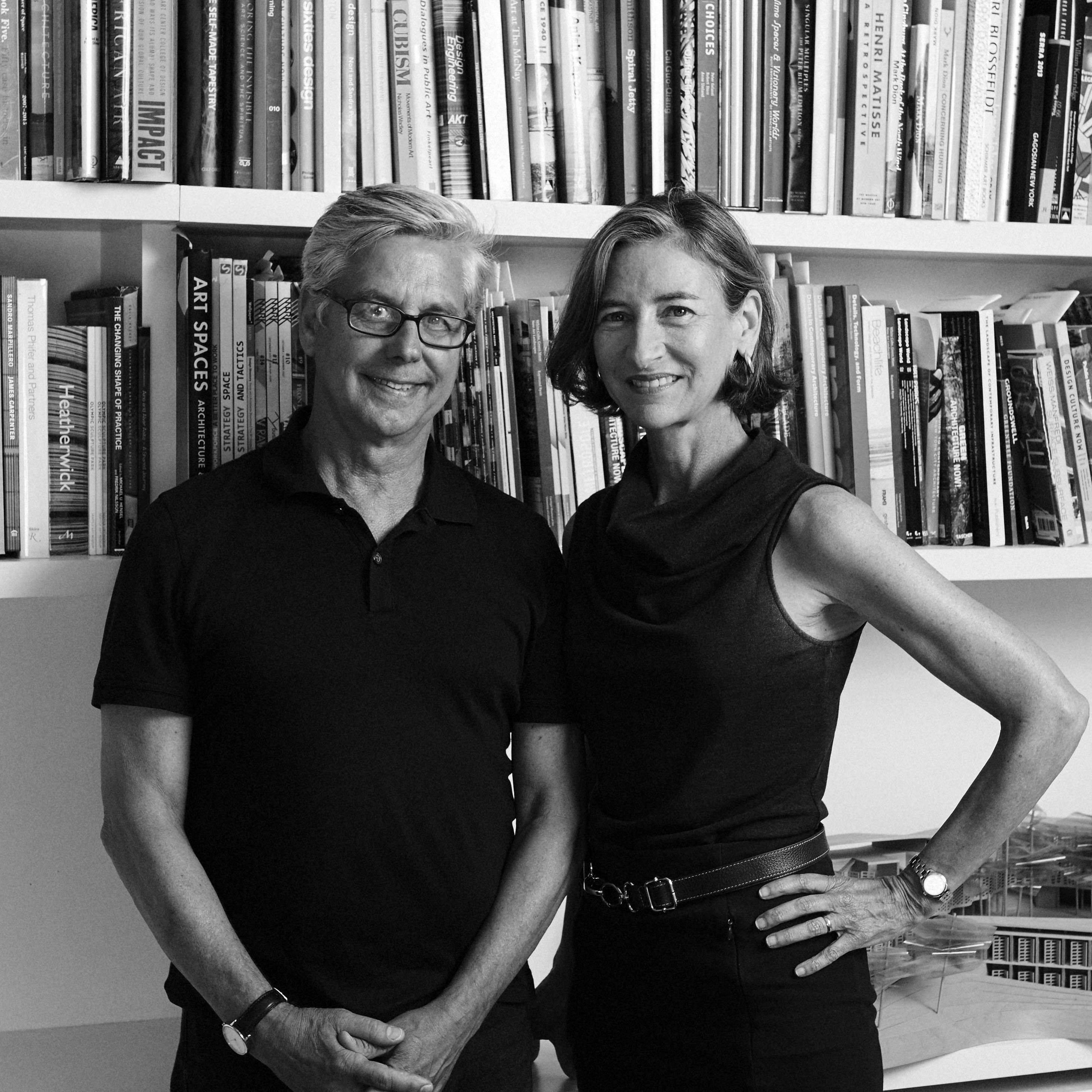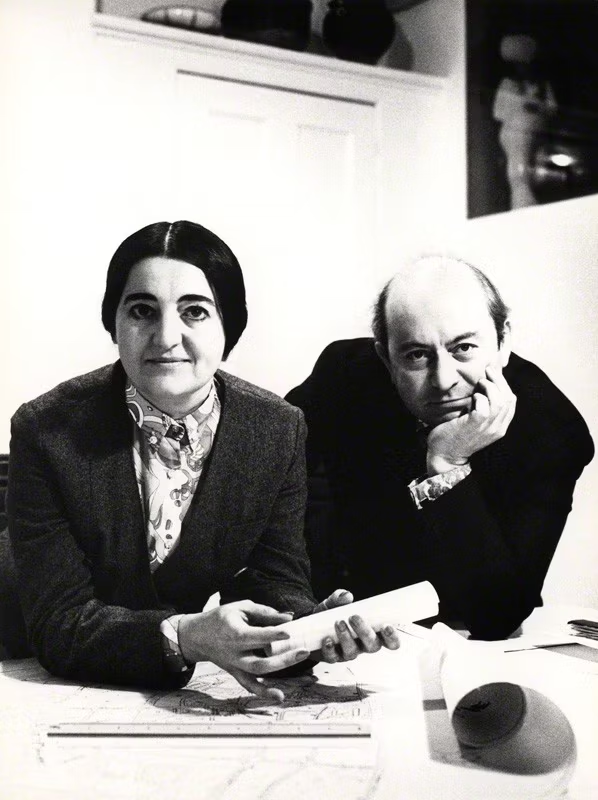The latest edition of “Architizer: The World’s Best Architecture” — a stunning, hardbound book celebrating the most inspiring contemporary architecture from around the globe — is now available. Order your copy today.
Denise Scott Brown and Robert Venturi, Lella Vignelli and Massimo Vignelli, Margaret McCurry and Stanley Tigerman, Frances Halsband and Robert Kliment, Diana Agrest and Mario Gandelsonas, Laurie Hawkinson and Henry Smith-Miller, Kimberly Jeanne Holden and Gregg Andrew Pasquarelli, Hani Rashid and Lise Anne Couture, Amale Andraos and Dan Wood, Coren and William Sharples, Ray and Charles Eames, Liz Diller and Ricardo Scofidio, Reima and Raili Pietilä, Eric Bunge and Mimi Hoang …
Do architects exclusively date other architects? The list above, which is in no way encyclopedic, represents just a few of the famous architects who have chosen to marry other architects. We left out the time you exchanged kisses with a studio mate over the drafting table, that missed connection on a Calatrava bridge, and the eye contact that was made (and held) at a Richard Meier retrospective.
Today we’re talking about partnerships. Specifically, we’re investigating the kind that have forged some of the best architecture of the last century: Ray and Charles, Liz and Ricardo, Denise and Robert. Monogamous by nature, architects build with scale, a sense of materiality, and are seduced by permanence. Their relationships mirror the cyclical gestures of an architectural practice: intense toil, a never-ending argument, rapid design, and an overwhelming elation.
Mimi Hoang and Eric Bunge, principles of nArchitects, keep a blackboard in their kitchen. Marrying an architect means never having to say you’re sorry (for spending 48 hours straight in the studio). Design, like prayer, becomes an all-consuming ritual. Taught the penance of long hours in grad school, architects marry other architects so that they can keep the conversation going.
Below, Architizer has profiled some of our favorite contemporary architectural love stories, giving an entirely new meaning to the phrase, “No, not that kind of partner.”

Jing Liu and Florian Idenburg
This couple took a fast path to designing a life together: Jin and Florian were married in 2006, welcomed two babies into their home by 2007, and established an architecture firm, SO-IL, by 2008. Jing Liu had just quit her job doing residential spa architecture and, with her husband, rented a desk space in DUMBO and picked up a license. When the market crashed mere months later, they did what anyone would do: desperately clung to their commissions while creating a new aesthetic formed by austerity, panic, and ephemerality. What saved them? “There’s something that the Dutch and Chinese share,” Liu observes. “Pragmatism.”
Their Derek Lam office materialized, a Dutch art collector’s new building evaporated, while a house for Ivan Chermayeff ended in a hole in the ground and a few construction drawings—an apt metaphor for their first year of practice.
Pole Dance, the commission that became their savior, was the winner of the MoMA PS1 Young Architects Program. “An interconnected system of poles and bungees whose equilibrium is open to human action and environmental factors” became a metaphor for the treacherous economic terrain. Their piece, and SO-IL itself, occupies the sliver of interstitial space between an unstable system and having just enough strength to stand. Much like their marriage, Liu explains in a recent article in the New Yorker, “We can afford to fight it out over days and days. You don’t chicken out of the argument. You just keep going at it until you have a resolution.”

Billie Tsien and Tod Williams
Billie and Tod see architecture as a practice of “profound optimism.” The walls of their stately pre-war Central Park office are surprisingly intimate, and also physically few; the moment they moved in all the doors were literally taken off. Similarly, their work is often institutional yet personal. Both architects attest to working at a slow but steady pace. Their process becomes a meditation on the only thing they love more than one another: materiality. The Barnes Foundation, The American Folk Art Museum, The Prospect Park Skating Rink.
The couple met in 1977 when Billie went to work at Tod’s firm. Nine years later, the two were married and had co-founded a firm whose work would eclipse each of their prior resumes. Their Wunderkammer project for the 2012 Venice Biennial was produced with their design prodigy son, Kai Williams. For the family practice, sensitive relationships replace starchitect lifestyle. Billie tells Architectural Digest, “I think the lie of architecture is that it has always been done by single men. Architecture is a collaborative process; it’s a journey that you need support on.”

Marion Weiss and Michael Manfredi
New York-based architects Weiss and Manfredi met while working in the office of Mitchell Giurgola, a former student of Louis Khan. They eventually formed Weiss/Manfredi Architects. Marion’s childhood in California was, literally, shaded by the apricot orchard in her backyard, while Michael spent his formative years in Rome’s countryside. Most famous for The Olympic Sculpture Park, they share a pious reverence for landscape.
Both architects are left-handed, and Michael admits that their etchings are often impossible to distinguish from one another. Rather than work in a bubble, individual authorship is erased through their creative process—reminding us that Ayn Rand never met an architect in love. The couple perseveres in the field’s high level of criticism, as Marion Weiss confided in a The New Yorker interview, “Being in a marriage diminishes the need to explain.”

Meejin Yoon and Eric Höweler
Principals of the firm Höweler + Yoon, this duo came to their shared practice from divergent backgrounds—Meejin at Dean/Wolf and Höweler at Diller Scofidio + Renfro. The (power) couple met while studying architecture at Cornell, and reportedly “had a nodding acquaintance that turned into a date four years later.” Working primarily with the intangible, they have grown out of Cornell’s orthodox emphasis on morphological analysis. They entered the architectural arena not with a building, but an immersive LED light installation for the Athens Olympics called White Noise White Light.
A testament to the dating tactic of staring really hard as a valid flirting strategy, Meejin and Eric were wed in Saarinen’s M.I.T Chapel. Meeric, as we’ve termed the pair, honeymooned in Brasilia to gain an intimate understanding of architectural evolution—winning, by default, Architizer’s Cutest Couple Award.

Flashback Romance: Alison and Peter Smithson
Peter Smithson, of Stockton-on-Tees, met Allison Gill when she enrolled in his architecture program in Newcastle, and the couple married in 1949. Their first commission, which shaped their following work, was the austere Hunstanton School. Built at the tail end of England’s steel rationing, the project embraced the idea of an eclectic assemblage and resisted modular building—which had become a tired trope of post-war architecture. Described by a teacher who spent 37 years there as a “tragedy”, the building represents their long career of not listening to the haters.
Proponents of the new Brutalist movement, the Smithsons were predestined to be unpopular—but found solace in each other. Peter, nicknamed Brutus, often said that “Brutalism is Brutus plus Allison.” They termed the Architectural Review a “festival of Britain’s effeminate aesthetic” and viewed a return to normalcy as a surrender of post-war experimentation. We salute the UK’s most romantic embrace of iconoclast design.
The judging process for Architizer's 12th Annual A+Awards is now away. Subscribe to our Awards Newsletter to receive updates about Public Voting, and stay tuned for winners announcements later this spring.









